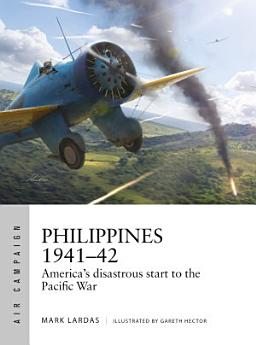Philippines 1941–42: America's disastrous start to the Pacific War
Mark Lardas
Jul 2026 · Air Campaign Book 62 · Bloomsbury Publishing
Ebook
96
Pages
infoThis book will become available on July 30, 2026. You will not be charged until it is released.
About this ebook
The weeks after Pearl Harbor saw Japan destroy the well-prepared US air forces in the Philippines. Fully illustrated, this studies the Pacific War's little-known first major air campaign.
On December 7, 1941, the Japanese not only attacked Pearl Harbor,but also struck at US and allied bases throughout the Pacific, including the USA's biggest overseas territory, the Philippines. However, that was an air battle the US was expecting. The USAAF had beefed up its assets in the Philippines, sending nearly a quarter of its available B-17s to the Far Eastern Air Force (FEAF).It could also call on the Philippine Army Air Corps (PAAC).
Aviation historian Mark Lardas explains how despite that, in a campaign that lasted barely a month, Japan's air forces routed both the FEAF and the PAAC, gaining air superiority and permitting Imperial Army troops undisturbed access to the Philippine coast. Within a week Japan ruled the skies over Luzon. Two weeks later it had air superiority over all the Philippines. After a month, its control was so complete the Imperial Army felt confident to move its 5th Air Group back out of the Philippines. While desultory air combat would continue off and on for the next three months, the issue was decided by 5 January 1942.
Packed with original artwork, 3D diagrams, maps and photos, this is the history of how the first air campaign of the Pacific War turned into a humiliating defeat for the United States.
On December 7, 1941, the Japanese not only attacked Pearl Harbor,but also struck at US and allied bases throughout the Pacific, including the USA's biggest overseas territory, the Philippines. However, that was an air battle the US was expecting. The USAAF had beefed up its assets in the Philippines, sending nearly a quarter of its available B-17s to the Far Eastern Air Force (FEAF).It could also call on the Philippine Army Air Corps (PAAC).
Aviation historian Mark Lardas explains how despite that, in a campaign that lasted barely a month, Japan's air forces routed both the FEAF and the PAAC, gaining air superiority and permitting Imperial Army troops undisturbed access to the Philippine coast. Within a week Japan ruled the skies over Luzon. Two weeks later it had air superiority over all the Philippines. After a month, its control was so complete the Imperial Army felt confident to move its 5th Air Group back out of the Philippines. While desultory air combat would continue off and on for the next three months, the issue was decided by 5 January 1942.
Packed with original artwork, 3D diagrams, maps and photos, this is the history of how the first air campaign of the Pacific War turned into a humiliating defeat for the United States.
About the author
Mark Lardas has always been fascinated by things related to the sea and sky. From building models of ships and aircraft as a teen, he then studied Naval Architecture and Marine Engineering, but his interest in aviation led him to take a job on the then-new Space Shuttle program, where he worked for the next 30 years as a navigation engineer. He has written numerous books on military, naval or maritime history.
Gareth Hector is an internationally renowned aviation artist who lives in Scotland.
Gareth Hector is an internationally renowned aviation artist who lives in Scotland.
Reading information
Smartphones and tablets
Install the Google Play Books app for Android and iPad/iPhone. It syncs automatically with your account and allows you to read online or offline wherever you are.
Laptops and computers
You can listen to audiobooks purchased on Google Play using your computer's web browser.
eReaders and other devices
To read on e-ink devices like Kobo eReaders, you'll need to download a file and transfer it to your device. Follow the detailed Help Center instructions to transfer the files to supported eReaders.










